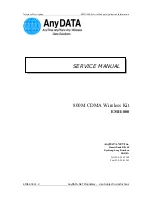
8.8. Comparison IGC- and FCC Standard
The RJ45 sockets are numbered in the document according to the international standard of the Federal
Communications Commission (FCC). Beside the FCC standard, there is also the International Gliding
Commission (https://www.fai.org/commission/igc) that has defined a standard for the interfaces of IGC loggers.
The XCTouchNav interface follows the IGC standard, but primarily uses the standard FCC numbering in this
document.
Figure 4 on the left shows the FCC standard, which designates the first pin in the top view of the connector as pin
8. Next to it on the right in Figure 5 is the wrongly numbered IGC standard (source: TECHNICAL
SPECIFICATION FOR IGC-APPROVED GNSS FLIGHT RECORDERS - Second Edition
with Amendment 7 31 January 2022). There the numbering of the first pin on the connector on the left begins with
pin 1 (!).
In order to assess whether the pin assignment of a device fits, when reading a document it is therefore always
necessary to check which standard the numbering follows, it is the IGC standard, the + 12V are numbered with
pins 1 and 2 on the left in the top view of the plug, with the FCC By default, the +12V are of course also on the
left, but are numbered with pins 7 and 8. Below is the table with a comparison of both numbering systems with a
comparison.
The IGC's incorrect numbering, which differs from the FCC, causes confusion in many cases. Manufacturers all
over the world number components, CAD symbols or cables are all according to the FCC standard, as do avionics
equipment manufacturers meanwhile again in there documentation. You cannot estimate whether the assignment
is correct with the pin number alone. A drawing of the connector must therefore always be taken into account.
Comparison of the pin numbers of the FCC and the (reversed) IGC standard:
Signal
RJ45
FCC Standard
Pin#
RJ45
IGC Standard
Pin#
Volts +
7+8
1+2
Data out (TX)
4
5
Data in (RX)
3
6
Earth (GND)
1+2
7+8
Page 17
Abbildung 3: FCC-Standard
Abbildung 4: IGC-Standard (reversed)






































